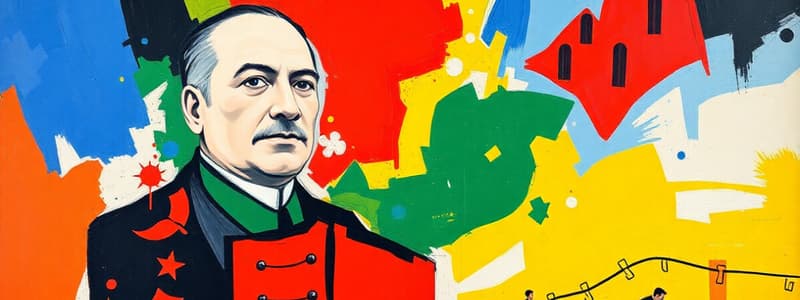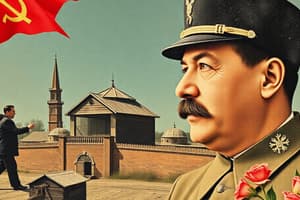Podcast
Questions and Answers
What was the primary purpose of the New Economic Policy (NEP)?
What was the primary purpose of the New Economic Policy (NEP)?
- To implement socialism immediately
- To temporarily revive the economy after the civil war (correct)
- To rapidly industrialize the Soviet Union
- To abolish all private property
The NEP allowed private ownership of large businesses.
The NEP allowed private ownership of large businesses.
False (B)
What group was created in 1921 to help plan the Soviet economy?
What group was created in 1921 to help plan the Soviet economy?
Gosplan
Under the five-year plans, private property was no longer allowed, and farming was organized into two types of farms: kolkhozes and _____ .
Under the five-year plans, private property was no longer allowed, and farming was organized into two types of farms: kolkhozes and _____ .
Match the following terms with their descriptions:
Match the following terms with their descriptions:
What significant action did Stalin take regarding the NEP in 1928?
What significant action did Stalin take regarding the NEP in 1928?
The initial five-year plan effectively increased the production of everyday goods such as clothes.
The initial five-year plan effectively increased the production of everyday goods such as clothes.
What negative consequence did the collectivization of land have on kulaks?
What negative consequence did the collectivization of land have on kulaks?
Flashcards
New Economic Policy (NEP)
New Economic Policy (NEP)
A policy implemented in the Soviet Union from 1921 to 1928, aiming to stabilize the economy after the civil war and the period of War Communism.
What did the NEP allow?
What did the NEP allow?
Allowed limited private ownership of businesses and permitted farmers to sell their surplus crops.
Kulaks
Kulaks
A group of wealthy farmers who benefited from the NEP, causing tension within the Soviet government.
What is Gosplan?
What is Gosplan?
Signup and view all the flashcards
Five-year plans
Five-year plans
Signup and view all the flashcards
Collectivization
Collectivization
Signup and view all the flashcards
Sovkhozes
Sovkhozes
Signup and view all the flashcards
Kolkhozes
Kolkhozes
Signup and view all the flashcards
Study Notes
New Economic Policy (NEP)
- NEP implemented in 1921, lasted until 1928.
- Created due to economic hardship following the civil war.
- Temporary plan to revive the economy.
- Allowed elements of market economy:
- Free crop sales by farmers.
- Private small/medium businesses.
- Domestic trade.
- Restored money system.
- Resulted in economic growth.
- Benefited wealthy farmers (kulaks).
- Caused internal government disputes.
Stalin's Shift from NEP
- In 1928, Stalin abandoned NEP.
- Sought greater government control over the economy.
- Established Gosplan (1921) to manage economic planning.
- Implemented five-year plans:
- Targeted economic catch-up, industrialization, and self-sufficiency.
- Set goals for production and resource allocation over five years.
- Aims to build strong military.
- Nationalized industry, agriculture, and trade.
- Eliminated private ownership.
Collectivization and its Consequences
- First five-year plan focused on land collectivization.
- Landowners forced to give up land, form collective farms (kolkhozes).
- Opposition from kulaks (wealthy farmers):
- Resistance, crop destruction.
- Government force, significant deaths, and loss of kulak class.
- Slowed production growth.
- Widespread hunger, millions of deaths.
Soviet Farming System
- Created two types of farms:
- Kolkhozes (community-owned).
- Sovkhozes (state-owned, paid labor).
- Both aimed to implement new technologies and practices.
- Farming sector remained a weak point in Soviet economy for many years.
Industrialization Focus
- Government prioritized heavy industry, energy production.
- Increased coal, oil, electricity production.
- Encouraged worker productivity.
- USSR emerged as powerful industrial nation, military capability.
- Manufacturing of essential consumer goods lagged behind military/industrial output.
- Reduced quality of life for many citizens.
Studying That Suits You
Use AI to generate personalized quizzes and flashcards to suit your learning preferences.




